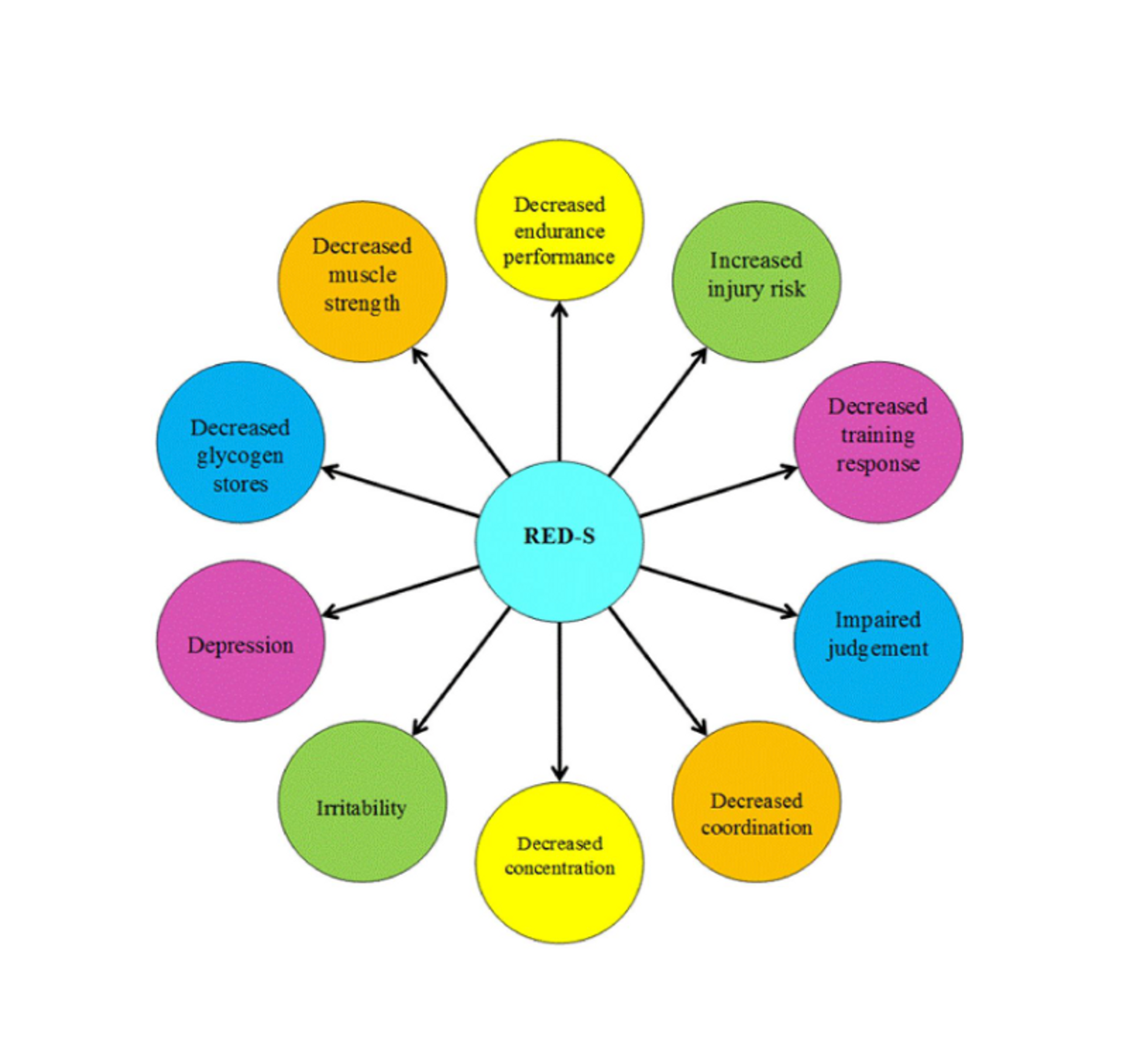

The term RED-S might seem pretty obscure and jargon-y, but in reality, it’s a simple—but very serious—condition, and it’s important for all athletes or people who work out regularly to be aware of it. RED-S, sometimes referred to as RED-S syndrome, stands for relative energy deficiency in sport, but it can affect people who don’t play any sports at all, and the consequences can be quite concerning. Read on to learn what exactly RED-S is, who’s at risk, how it relates to eating disorders, and more.
What is relative energy deficiency in sport (RED-S)?
First, let’s unpack what we mean when we talk about RED-S. The term “relative energy deficiency in sport,” better known as RED-S, was coined by the International Olympic Committee in 2014 to reflect the numerous consequences of low energy availability (LEA), a state when the body doesn’t have enough calories to support all of its functions. More simply put, it describes what happens to a person’s body when their food intake is too low to meet the demands of living and physical activity.
The RED-S framework replaced and retired the less inclusive phrase “female athlete triad,” which had been in use since 1992. The female athlete triad described a cluster of three symptoms frequently experienced by female athletes who weren’t properly fueling their bodies: menstrual dysfunction, decreased bone density, and low energy availability. This descriptor was incomplete for a few reasons. First, it failed to acknowledge that the consequences of low intake impact people across the gender spectrum; and second, it missed the many other symptoms that can come when an athlete or someone who works out regularly isn’t properly renourishing.
The diagram below shows the physiological outcomes associated with RED-S. As you can see, under this new framework, the female athlete triad is a subset of RED-S.

RED-S also leads to declining athletic performance. The diagram below shows the different ways performance can be impaired by low intake, which are related to the physiological symptoms above (for instance, mood instability will often impact training response and performance, poor bone health will increase injury risk, etc.):

The physiological health risks associated with RED-S are:
- Reproductive/sexual health: irregular or absent periods (in menstruating females), low libido
- Poor bone health: low bone density, increased risk of stress fractures, early onset osteoporosis
- Reduced immune function: frequent colds, increased risk of infection
- Metabolic issues: slowed metabolism, as the body holds onto food for longer and processes it more slowly
- Gastrointestinal distress: slowed digestion can lead to gas, constipation, and bloating, among other GI issues
- Cardiovascular issues: low heart rate, which can cause dizziness and the potential for long-term heart damage
- Psychological repercussions: anxiety, depression, impaired concentration and focus
- Vitamin and mineral deficiencies: such as iron, B12, and zinc
- Delayed growth/development: falling off the growth curve, failing to gain expected weight and/or height
- Hormonal disruption: imbalance levels of important hormones, like testosterone and estrogen

What’s the connection between RED-S and eating disorders?
If you’re familiar with the physical consequences of eating disorders, you might notice that there’s a lot of overlap with the symptoms of RED-S. This isn’t a coincidence, given that low energy intake (not eating enough food) is a driving force for both. What’s more, many people with eating disorders engage in compulsive exercise, making them more vulnerable to the performance-based symptoms of RED-S as well as the physiological ones.
As RED-S is a relatively new framework, research on RED-S and eating disorders is still in its infancy. But we do know that both are underrecognized in athletes, and both RED-S and most eating disorders share low energy intake as a core feature. There’s also the fact that disordered and restrictive eating is strikingly common among athletes. According to the recently published Female Athlete Report:
- A staggering 91% of the female athletes surveyed admitted to worrying about their calorie intake
- Half reported restricting calories in hopes of improving performance or changing their weight or shape
- Half reported having at least two symptoms of RED-S, while roughly one-third reported having five or more symptoms.
We’re still learning about the connection between RED-S and eating disorders, but there are a few key takeaways here. First, it’s important to remember that not everyone with an eating disorder has RED-S, and not everyone with RED-S has an eating disorder. That said, both are associated with undernutrition, which has significant health consequences regardless of the root cause. Additionally, dieting and restrictive eating for any reason raises a person’s risk of developing an eating disorder. Often RED-S is associated with a disorder known as anorexia athletica.
Dispelling common myths about RED-S
Despite the fact that RED-S is common among athletes, and that many people with eating disorders also have RED-S, most people haven’t heard of RED-S. And among those who do know about it, there are many misconceptions around what it is and who it affects. Those misconceptions can make identifying RED-S and getting appropriate help a challenge.
Let’s talk about a few of the most common myths around RED-S:
1. Myth: RED-S is only a concern for competitive athletes.
Despite “sport” being part of the name, any person engaging in regular exercise (i.e. “recreational” athletes, or people who don’t identify as an athlete but work out frequently) and not eating enough to meet the demands of life and activity can suffer from RED-S.
2. Myth: Low body weight is part of the criteria for RED-S.
Athletes who are not “low weight” are actually at higher risk for developing symptoms of RED-S, as they’re often dismissed or overlooked precisely because they’re at a “normal” weight. Additionally, athletes who don’t fit that “athletic aesthetic” (a certain ideal of a “fit” body that’s often upheld in athletic circles) may feel pressured to go to extreme lengths to change their bodies, making them even more susceptible.
3. Myth: RED-S only occurs in cisgender females
In part because of the older “female athlete triad” framework, many people still assume that only cisgender females are at risk for RED-S. But we know now that the harms of low energy availability don’t discriminate: they affect people across the gender spectrum.
4. Myth: RED-S only affects those who are intentionally trying to lose weight or eat less.
This is a huge misconception. The body doesn’t care if the restriction or underfueling is willful or purely accidental. Let’s add to that the fact that adequate calorie intake is only half the battle — timing of meals and snacks are of crucial importance as well for decreasing risk of injury and enabling peak performance. Sometimes, even well intended efforts to meet the energy demands of training may not be enough to avoid RED-S if an athlete isn’t eating at the right times.
5. Myth: The consequences of RED-S can be avoided by taking hormonal contraception (i.e. birth control pills).
When a person is taking hormonal contraceptives, what they experience is withdrawal bleeding, not an actual period. Getting what appears to be a period gets rid of one concrete marker of low energy availability, but pill users with RED-S actually have a hormonal profile that is identical to that of an amenorrheic athlete (aka an athlete who doesn’t get a period at all). These hormonal disruptions have a number of negative health implications, including increased injury risk and decreased bone density, for example.
If you’re concerned that you or someone you love might be dealing with RED-S, it’s important to get informed and seek help if you need it. Here are a few great resources:
- The Consensus Statement by the International Olympic Committee from 2014 that made RED-S a thing
- The Project RED-S website, dedicated to awareness and prevention efforts, is a wonderful resource for both athletes and their supporters.

- Mountjoy, Margo et al. “The IOC consensus statement: beyond the Female Athlete Triad--Relative Energy Deficiency in Sport (RED-S).” British journal of sports medicine vol. 48,7 (2014): 491-7. doi:10.1136/bjsports-2014-093502
- Cabre, H E et al. “Relative Energy Deficiency in Sport (RED-S): Scientific, Clinical, and Practical Implications for the Female Athlete.” Deutsche Zeitschrift fur Sportmedizin vol. 73,7 (2022): 225-234. doi:10.5960/dzsm.2022.546
- Dipla, Konstantina et al. “Relative energy deficiency in sports (RED-S): elucidation of endocrine changes affecting the health of males and females.” Hormones (Athens, Greece) vol. 20,1 (2021): 35-47. doi:10.1007/s42000-020-00214-w







